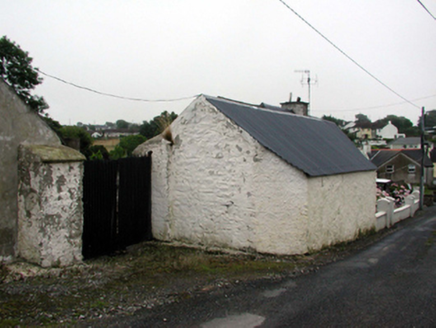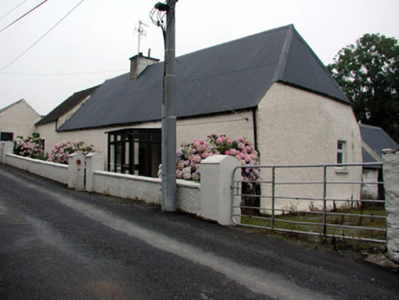Survey Data
Reg No
22811027
Rating
Regional
Categories of Special Interest
Architectural, Social
Original Use
House
In Use As
House
Date
1740 - 1760
Coordinates
236810, 97782
Date Recorded
11/08/2003
Date Updated
--/--/--
Description
Detached two-bay single-storey cottage, c.1750, originally thatched. Renovated and extended, c.1900, comprising single-bay single-storey higher end bay to west. Extensively renovated and extended, c.1975, comprising single-bay single-storey flat-roofed return to north with single-bay single-storey flat-roofed projecting glazed porch added. Hipped gabled roof with replacement corrugated-iron, c.1975, possibly over original thatch with iron ridge tiles, rendered chimney stack, and replacement uPVC rainwater goods, c.2000. Pitched roof to end bay with replacement fibre-cement slate, c.1975, clay ridge tiles, and replacement uPVC rainwater goods, c.2000, on rendered eaves. Flat felt roof to return. Flat corrugated-iron roof to porch. Painted replacement roughcast walls, c.1900, with rendered quoins, and band to eaves. Square-headed window openings (continuous to porch) with replacement concrete sills, c.1975, and replacement timber casement windows, c.1975. Square-headed door opening with glazed timber panelled door, c.1975. Set back from line of road in own grounds with forecourt, and painted roughcast boundary wall to perimeter. (ii) Attached single-bay single-storey outbuilding, c.1750, to west originally detached. Reroofed, c.1975. Pitched roof with replacement corrugated-iron, c.1975, and iron ridge tiles. Painted lime rendered walls over random rubble stone construction with chamfered corner to south-west. Openings not visible (none to road (south) front). (iii) Attached single-bay single-storey outbuilding, c.1900, to north-east. Reroofed, c.1975. Pitched roof with replacement corrugated-iron, c.1975, and iron ridge tiles. Painted lime rendered walls over random rubble stone construction. Openings not visible.
Appraisal
An appealing, modest-scale cottage forming an important element of the vernacular heritage of County Waterford, as identified by the traditional construction, the informal arrangement to the small-scale openings. It is also possible that a thatched roof survives under the present covering; the use of corrugated-iron as a roofing material is also interpreted as being of vernacular significance. Comprehensively renovated in the late twentieth century, the cottage retains much of its original form and massing, although the unsympathetic replacement fittings to the openings have not had a positive bearing on the external expression of the composition. The survival of a range of outbuildings enhances the setting quality of the site, the collective group contributing positively to the character of the locality.



